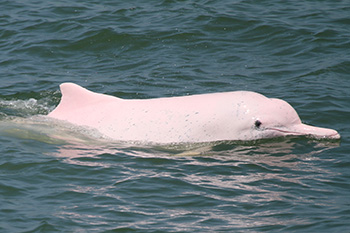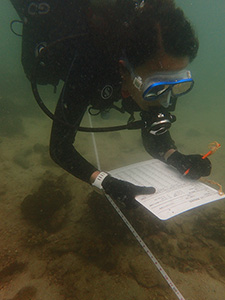| Country and Marine Parks |
WORK OF THE COUNTRY AND MARINE PARKS BRANCH
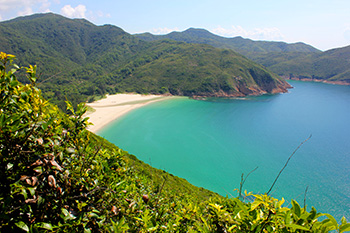
|
COUNTRY AND MARINE PARKS
To conserve the countryside, as at March 2016, 44,300 hectares (about 40% of Hong Kong's total land area) have been designated as country parks and special areas. The Department manages 24 country parks and 22 special areas for conservation, recreation, education and tourism. Hiking trails, mountain bike trails, nature trails, barbecue and picnic sites, camp sites and visitor centres are provided in the country parks, drawing some 13.29 million visitors in 2015-16.
The Department manages four marine parks and one marine reserve covering 2,430 hectares for conservation, education and scientific studies. Marine parks, which are also for recreation, comprise scenic coastal areas, seascapes and important marine habitats with an abundance of important marine fauna and flora, providing ideal opportunities for diving, snorkelling, canoeing and underwater photography. Some 125,000 visitors to marine parks were recorded in 2015-16.
A map showing the country parks, special areas, marine parks, marine reserve and the Hong Kong Global Geopark of China is at Appendix 13.
|
COUNTRY PARK ENCLAVES
In the year, the Department kicked off the statutory procedures to incorporate two enclaves, namely Fan Kei Tok and Sai Lau Kong, into the Plover Cove Country Park, and another enclave at a site near Nam Shan into the Lantau South Country Park.
PROPOSED MARINE PARKS
The Department had started in the year proceeding with the statutory designation procedures of the proposed Brothers Marine Park (BMP) which is as a condition in the Environmental Permit for the Hong Kong-Zhuhai-Macau Bridge - Hong Kong Boundary Crossing Facilities Project. The designation was expected to complete by the end of 2016. In response to public concern over protecting Chinese white dolphins, the Department was also preparing for the designation of the proposed Southwest Lantau Marine Park and Soko Islands Marine Park.
HILL FIRES
In 2015-16, 11 hill fires occurred over an area of 147 hectares with 12,435 trees damaged within or adjacent to country parks. The scale of one of the hill fires occurred in Shing Mun Country Park was relatively large and caused considerable damage to the vegetation. Rehabilitation planting programme in areas damaged by hill fires and various fire prevention measures had been implemented.
TREE PLANTING
Seedlings are produced in Tai Tong Nursery for tree planting in country parks. Located in Tai Lam Country Park with an area of 9.5 hectares, the nursery produced over 410,900 seedlings of more than 100 species in 2015-16.
|
COUNTRY PARK PLANTATION ENRICHMENT PROJECT
In the early years, exotic pioneer species such as Taiwan Acacia (Acacia confusa), Brisbane Box (Lophostemon confertus) and Slash Pine (Pinus elliottii) were planted to prevent soil erosion and to quickly restore vegetation cover. This objective has been achieved with sustained efforts in the last few decades.
With time, existing plantations in country parks are facing problems such as aging, withering and overgrowing. Trees species found within the plantations are relatively uniform comprising mainly exotic species, making it difficult for them to fully satisfy the needs of native wildlife for food and shelters. In addition, the dense canopies of the trees could have affected the natural propagation of native trees. To enhance the landscape and ecological value of these existing plantations, the Department launched the Country Park Plantation Enrichment Project (PEP) in 2009 to enrich the overall value of country park plantations. During the dry season of 2015, about 4,000 exotic trees within plantation areas were removed under the PEP. Over 6,500 suitable native tree seedlings were planted in the plantation areas in the following planting season. It is expected that the newly planted seedlings would gradually establish in the plantation, and eventually replace all the exotic species. The Department will continue to carry out the PEP in the coming years to improve the plantations in country parks systematically with a view to enhancing the overall ecological value of the country parks.
TREE MANAGEMENT
To improve tree management in Hong Kong for public safety, the Department has stepped up efforts on tree inspection, risk assessment and tree maintenance at the recreation sites of country parks and the areas adjacent to non-expressway public roads. Over 38,900 trees (involving about 1,100 sites and 660 tree groups adjacent to public roads) and six Old and Valuable Trees have been inspected. During the year, tree management measures such as pruning and thinning, were prescribed for trees in poor health conditions or with high potential danger to the public. Tree management work was carried out by qualified and experienced in-house staff.
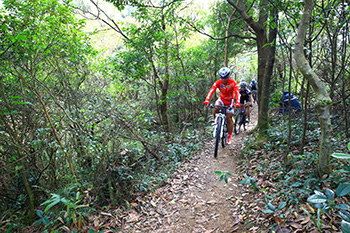 MOUNTAIN BIKE ACTIVITIES MOUNTAIN BIKE ACTIVITIES
The Tin Fu Tsai North Section of mountain bike trail in Tai Lam Country Park opened in December 2015. The 5.9km long new trail is designed as a sustainable trail meeting standards set by the International Mountain Bicycling Association. Installed with a number of challenging features such as berms, rock garden and drop-off, the narrow and winding route is suitable for cyclists with intermediate or advanced mountain biking skills. It is also the first mountain bike trail with distance posts so that bikers encountering emergencies can accurately report their locations to rescue teams and receive prompt assistance.
|
HONG KONG UNESCO GLOBAL GEOPARK
Hong Kong Geopark was opened in 2009 and acquired its global status in 2011. With the formalisation of the new label "UNESCO Global Geopark", Hong Kong Geopark was renamed as "Hong Kong UNESCO Global Geopark" (HKUGG) in November 2015. To ensure the HKUGG benefits the environment, local people and the economy, the Department works closely with local communities and non-government organisations. There are three local geoheritage centres managed by local communities and a Volcano Discovery Centre (VDC) operated by a local community organisation. Served as a gateway to HKUGG, the VDC facilitated around 66,000 visitors to explore the geopark in 2015-16. The Department continued to explore opportunities to engage local communities in new geopark initiatives.
|
On global networking, the HKUGG and the Ministry of Land and Resources General Office of the Science-Popularization Department co-organised the first Geoscience Capacity-Building Programme. Participants were from about 30 global geoparks, academic institutes and other science-popularisation bases in Mainland, Germany, the United Kingdom, Canada, Uruguay, Japan and Australia, etc. A number of guided visits and sharing sessions were organised for representatives from Global Geoparks Network such as Mainland, Sweden, Italy, Malaysia and Japan.
In 2015, more than 20 primary and secondary schools participated in the Hong Kong Global Geopark School Programme which was one of the major science-popularisation initiatives. Programme activities included talks, workshops, guided visits, exhibitions and "Global E-classroom" sessions. In addition, HKUGG organised a series of talks at universities in Hong Kong to promote the geopark concept and to help students develop effective science transfer skills.
|
MANAGEMENT OF MARINE PARKS
To cope with the rising number of visitors to our Marine Parks, the Department has adopted a series of measures including strengthening patrols, assigning volunteers to disseminate codes for visitors, arrangement of guided activities and publication of educational materials. Law enforcement action was also stepped up to combat illegal activities.
NATURE CONSERVATION EDUCATION
School education programme implemented this year included Country Parks Orienteering, Kindergarten, Primary School and Secondary School Visits, Country Parks Day Camp, school eco-tours and teacher's workshops.
|
In addition, a number of hiking events including "Hiking and Planting Day", "CAS Hiking Safety Promotion Day" and "Keep Fit Party Hiking Event" were held to introduce to the public the fun of hiking and the associated safety knowledge.
|
During 2015, 165 volunteers completed the basic volunteer training under the Country Park Volunteer Scheme. A total of 587 trained volunteers served 33,463 man hours in the country parks conservation and education activities including publicity events, roving exhibitions, guided tours, hiking route patrols, and vegetation management.
|
MARINE CONSERVATION EDUCATION
The Department organised a variety of marine conservation education activities targeting various sectors of the community. During the year, 83 public eco-tours, 11 public seminars, 3 beach clean-up activities, 26 school lectures, 37 exhibitions and 23 other kinds of educational activities were held, benefiting over 52,000 participants.
During the year, a total of 147 Marine Parks Ambassador participated in 4 volunteer service, 6 activities and 2 training sessions to help promote marine conservation.
The Department organised 12 dolphin field trips for secondary school teachers and students in collaboration with the Ocean Park Conservation Foundation Hong Kong in 2015-16. The field trips provided opportunities for students to watch Chinese white dolphins and to learn more about marine conservation.
During the year, the Department launched a series of publicity and educational activities under Ting Kok Coastal Conservation Plan. These activities included the creation of a website, publication of pamphlets, designation of tour routes and provision of coastal clean-up as well as eco-tour services for visitors.
|
LAW ENFORCEMENT
Park wardens patrol country parks and special areas on a regular basis to provide visitor services and to enforce the Country Parks Ordinance (Cap 208) and related legislation. In 2015-16, there were 790 concluded prosecution cases in relation to offences in countryside. Statistics are at Appendix 14. Park wardens and nature wardens also conducted frequent special operations in the country parks, such as searching for illegal animal traps, visiting villages for the promotion of fire prevention, enforcing prohibition of feeding wild animals and assisting the Police in search-and-rescue exercises. Regular joint operations with the Police were undertaken to combat crimes, such as illegal felling of Buddhist Pines and Incense Trees.
In marine parks and reserve, wardens patrol on a daily basis, watching out for any illegal fishing activities. Close liaison is also maintained with the Marine Police and the Fisheries Authority of Shenzhen to combat illegal fishing by Mainland fishermen in marine parks. Wardens give advice or warnings to visitors and institute prosecutions when necessary. In 2015-16, 16 prosecutions were instituted against illegal fishing activities in marine parks.
MARINE CONSERVATION
Reef Check
|
Apart from Ung Kong Wan, Sharp Island West and Port Island, specially-designed marker buoys were also installed at South Ninepin, Shelter Island and Sharp Island East during this year to protect more corals from anchoring damage. Regular sea patrols and underwater ecological surveys were also conducted to monitor the effectiveness of the coral marker buoys in these areas, and the results to date are encouraging. There has been an overall increase in live coral cover in the marker buoy area. Damaged corals have shown signs of recovery.
|
Conservation of Marine Mammals
Every reported dolphin stranding in Hong Kong was investigated by the Department in collaboration with the Ocean Park Conservation Foundation. Tissue samples from the carcasses were collected for further studies. The Department continued to hold exhibitions and seminars as well as to distribute posters and leaflets to promote conservation of marine mammals, and publicise the code of conduct on dolphin watching and the dolphin stranding hotline. Through these efforts, the public gradually deepened their understanding of marine mammals.
|
Underwater Ecological Surveys
In 2011, the Department formed a diving team for underwater ecological survey comprising staff members who were experienced in scuba diving and underwater ecological survey. During the year, the diving team continued to undertake thematic projects such as the long-term monitoring programmes for hard and soft coral, gorgonian, black coral and reef fish, and focused studies on coral ecology and algae diversity.
|
ENVIRONMENTAL IMPACT ASSESSMENT STUDIES
The Department regularly provides comments and advice on development proposals and projects as well as Environmental Impact Assessment studies to ensure that potential impacts of development projects on the marine environment and ecology would be adequately addressed, evaluated and minimised through effective mitigation.


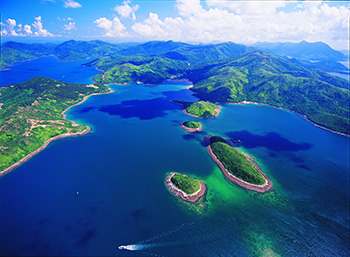
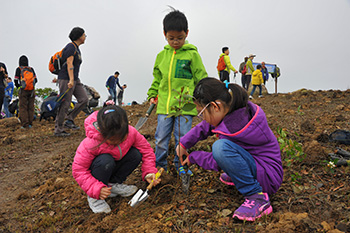 Some 410,900 seedlings were planted in country parks in 2015-16. To enrich local plant diversity, the Department continued to produce and plant seedlings of native tree species. Major native species planted included Castanopsis (Castanopsis fissa), Gordonia (Gordonia axillaris), Sweet Gum (Liquidambar formosana), Zhejiang Machilus (Machilus chekiangensis), Many-nerved Machilus (Machilus pauhoi) and Chinese Gugertree (Schima superba). Among the seedlings planted, about 80% were native species.
Some 410,900 seedlings were planted in country parks in 2015-16. To enrich local plant diversity, the Department continued to produce and plant seedlings of native tree species. Major native species planted included Castanopsis (Castanopsis fissa), Gordonia (Gordonia axillaris), Sweet Gum (Liquidambar formosana), Zhejiang Machilus (Machilus chekiangensis), Many-nerved Machilus (Machilus pauhoi) and Chinese Gugertree (Schima superba). Among the seedlings planted, about 80% were native species. 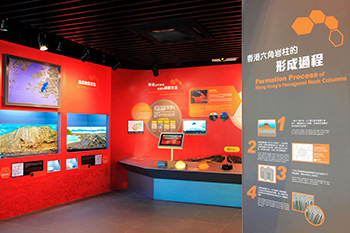 A geopark is a unique natural area with special geological significance and includes facets of natural and cultural heritage. With the objectives of conservation, education and sustainable development, the geopark in Hong Kong protects Hong Kong's rich geological resources, many of which are of high research, tourism, educational and scenic value.
A geopark is a unique natural area with special geological significance and includes facets of natural and cultural heritage. With the objectives of conservation, education and sustainable development, the geopark in Hong Kong protects Hong Kong's rich geological resources, many of which are of high research, tourism, educational and scenic value.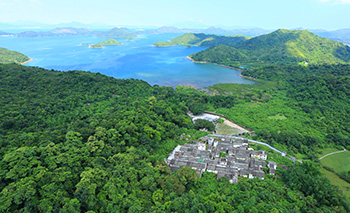 The HKUGG strove to enhance the accessibility to geo-sites. A Kaito ferry service between Ma Liu Shui and Lai Chi Wo commenced operation in January 2016. It significantly enhanced the accessibility to the area and demonstrated the cooperation between the government and with local communities.
The HKUGG strove to enhance the accessibility to geo-sites. A Kaito ferry service between Ma Liu Shui and Lai Chi Wo commenced operation in January 2016. It significantly enhanced the accessibility to the area and demonstrated the cooperation between the government and with local communities. 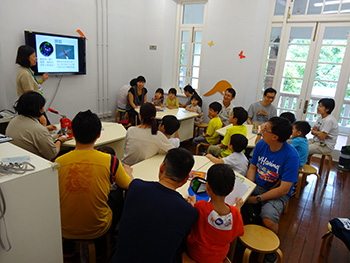 In 2015-16, the Department conducted a series of conservation activities for over 340,000 local students, teachers and nature lovers. The Department continued to carry out the Country Parks Education Programme "Nature in Touch" to strengthen the educational resources on nature conservation in country parks. This programme aimed at promoting a better understanding of country parks, biodiversity, flora conservation and geological characteristics in Hong Kong, thus enhancing public awareness of the importance in protecting the natural environment. The programme included a series of countryside learning activities for students and nature appreciation activities for the public.
In 2015-16, the Department conducted a series of conservation activities for over 340,000 local students, teachers and nature lovers. The Department continued to carry out the Country Parks Education Programme "Nature in Touch" to strengthen the educational resources on nature conservation in country parks. This programme aimed at promoting a better understanding of country parks, biodiversity, flora conservation and geological characteristics in Hong Kong, thus enhancing public awareness of the importance in protecting the natural environment. The programme included a series of countryside learning activities for students and nature appreciation activities for the public. 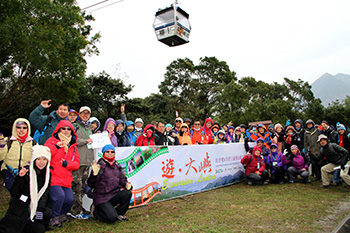 During the year, a wide variety of public education activities including Nature Education Centre and outdoor guided tours, "Nature in touch" workshops and family day programme were held. To promote the scenic attractions at Lantau Country Parks, a series of themed activities such as photo exhibitions, photography competitions and public lectures were organised.
During the year, a wide variety of public education activities including Nature Education Centre and outdoor guided tours, "Nature in touch" workshops and family day programme were held. To promote the scenic attractions at Lantau Country Parks, a series of themed activities such as photo exhibitions, photography competitions and public lectures were organised. 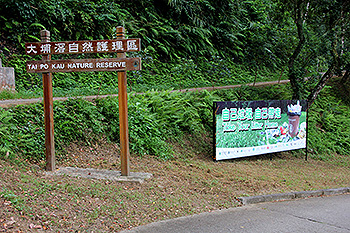 With a view to nurturing among the public an environmentally responsible habit of taking away waste after hiking in country parks, the Department launched the public education programme "Take Your Litter Home" in September 2015 with the support of green groups and hiking groups. Five trial sites, namely Tai Po Kau Nature Reserve, Ma On Shan Country Trail, Tai Lam Chung Country Trail, Dragon's Back on Hong Kong Island and Lantau Trail Section 3, were made litter-bin free for observation of the effectiveness of the programme.
With a view to nurturing among the public an environmentally responsible habit of taking away waste after hiking in country parks, the Department launched the public education programme "Take Your Litter Home" in September 2015 with the support of green groups and hiking groups. Five trial sites, namely Tai Po Kau Nature Reserve, Ma On Shan Country Trail, Tai Lam Chung Country Trail, Dragon's Back on Hong Kong Island and Lantau Trail Section 3, were made litter-bin free for observation of the effectiveness of the programme.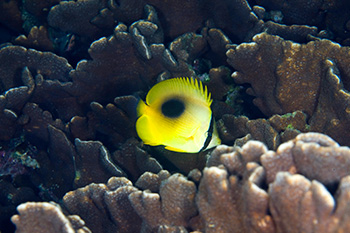 To promote the beauty of marine life and habitats as well as enhance public awareness of the importance in conservation of our marine environment, the Department and the Hong Kong Underwater Association co-organised the "Hong Kong Underwater Photo and Video Competition 2015" from May to October 2015. The competition was well-received with a total of 438 entries submitted. The winning entries were exhibited in roving exhibitions at Olympic House, Hong Kong Wetland Park and Hong Kong Convention and Exhibition Centre between October and December 2015.
To promote the beauty of marine life and habitats as well as enhance public awareness of the importance in conservation of our marine environment, the Department and the Hong Kong Underwater Association co-organised the "Hong Kong Underwater Photo and Video Competition 2015" from May to October 2015. The competition was well-received with a total of 438 entries submitted. The winning entries were exhibited in roving exhibitions at Olympic House, Hong Kong Wetland Park and Hong Kong Convention and Exhibition Centre between October and December 2015.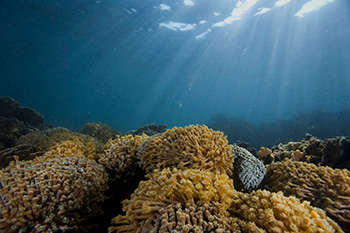
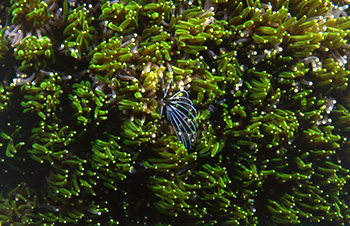 Conservation of Corals
Conservation of Corals 